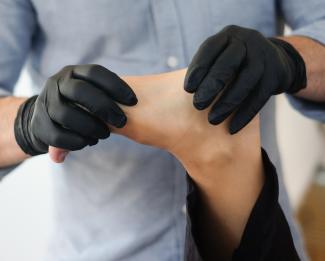
How do I Recover from a Sprained Ankle?
Ankle sprains are unfortunately very common for people of all ages and are the most common lower extremity injury. An ankle sprain can cause severe pain, swelling and decreased range of motion which can affect one’s ability walk and perform normal daily activities.
So, what exactly is an ankle sprain? It is an injury to the ligaments that surround the ankle joint. The purpose of ligaments (type of connective tissue that connect bone to bone) is to provide static stability to a particular joint. During an inversion ankle sprain, the most common type of ankle injury, is when the foot turns inward and the ligaments on the outside of the ankle are stretched or even torn. Rehab following an ankle sprain is dependent on the extent of injury:
- Grade I: mild sprain, 2-4 weeks
- Grade II: moderate, 1-2 months
- Grade III: severe, complete ligament tear, 3+ months
Before being seen by your physical therapist a doctor may order an x-ray to rule out a fracture. A patient must meet specific criteria to be considered appropriate for an x-ray. Once a fracture is ruled out, your physical therapist will begin the rehab process. The long-used R.I.C.E. principle for treating acute injuries is no longer the gold standard for treatment. This acronym stands for Rest, Ice, Compression and Elevation. More recently, physical therapist and athletic trainers have adopted the P.O.L.I.C.E. principle, which deviates slightly from R.I.C.E. however the rest is replaced with optimal loading and movement. This is done to ensure the injured body part remains mobile and reduces stiffness.
Protection: emphasizes importance of avoiding further damage to the injured joint but does not mean immobilization. Rest is good for a couple days following injury to a joint, muscle or ligament. After this initial rest, gentle range of motion can be performed while maintaining protection of the injured area.
Optimal Loading: Applying healthy sub-maximal loads to the injured tissues that stimulate the healing process. Research has shown that when injured tissue undergoes appropriate mechanical stress there is a physiological response at the cellular level vital in the healing process.
Ice: ice may help address swelling and can decrease acute pain.
Compression: can help with swelling in the affected area.
Elevation: can help with swelling and removing excessive fluid in the affected area.
Your physical therapist will progress you in the “optimal loading” portion of P.O.L.I.C.E. Once pain and swelling are under control, you will begin gentle, pain-free range of motion exercises to improve mobility of the joint. Once you gain the ability to bear weight and walk comfortably, your PT will progress strengthening exercises for not only the ankle but the hips and glutes which serve to help stabilize the ankle. Strengthening and balance training will be progressed from double to single leg exercises to simulate normal daily or recreational activities.
For more information, please contact your local orthopedic physical therapist for an assessment of your injured ankle to begin the journey back to performing your favorite activities with less pain. Physical Therapists improve the way you move!
Ryan Hastie, PT, DPT, CSCS
Doctor of Physical Therapy
Certified Strength and Conditioning Specialist
Titleist Performance Institute Medical 2 Certified


